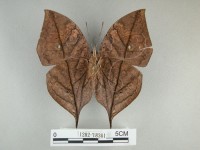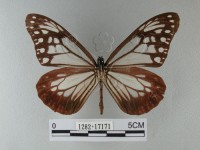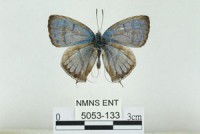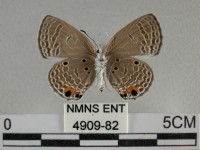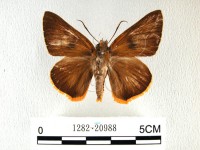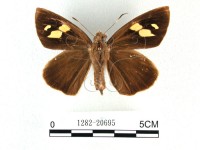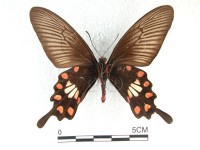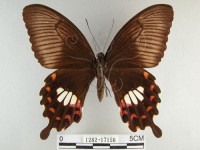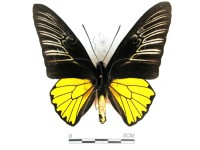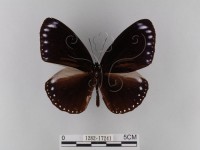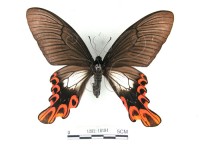TELDAP Collections
| Butterflies of Formosa - Details |
|
Dead Leaf Butterfly (Kallima inachus formosanus Fruhstorfer) The Dead Leaf Butterfly, Kallima inachus, is a classic example. When wings are folded, the butterfly looks like a dried leaf with dark veins, mold specks, and cavities. Wing patterns on ventral sides of the Dead Leaf Butterfly vary considerably with individual.
Chestnut Tiger Butterfly (Parantica sita niphonica (Moore))
In 1980, Japan began marking and recapturing Chestnut Tiger Butterflies to understand movements. Twenty years of study has shown that movements of these butterflies are dispersal that are non-overwintering and non-directional. Japanese scientists believed the Japan and Taiwan populations of Chestnut Tigers must overlap. To test this hypothesis, they enthusiastically started marking Taiwan's Chestnut Tigers. This study failed because too few people were involved. In 2000, National Taiwan University cooperated with Yangmingshan National Park by marking and recapturing Chestnut Tigers in the Datun Mountain to estimate the butterfly's population sizes. Three of these marked individuals were later found in Japan: in Kagoshima and Honshu in 2000 and in Kyushu in 2003.
Chestnut Tigers marked in Japan were also found in Taiwan: in 2001 in Daren, Taitung County, and in Yangmingshan National Park, Taipei County; and in 2005 on Gueishan Island, Ilan County. These recapture records confirm the populations of Chestnut Tigers in Taiwan and Japan do overlap. Although massive numbers of Chestnut Tigers have been marked in both Taiwan and Japan, the recapture rate is very low. This suggests the overlap in populations is accidental as occasional butterflies are blown on winds such as the northeast monsoons.
The Paper Kite (Idea leuconoe Erichson)
The Paper Kite is the largest danaid butterfly in Taiwan. It is oceanic in origin, widely distributed in Philippines, Borneo, Malay Peninsula Indonesia, Taiwan and southwestern islands of Japan. Many subspecies have been described from different islands. For example, nine subspecies are known from the Philippines alone. In Taiwan, there are two subspecies, I. leuconoe clara Butler and I. leuconoe kwashotoensis Sonan. The subspecies kwashotoensis is endemic to Green Island. a small volcanic island in Taiwan’s southeastern offshore. These two subspecies are different from each both in wing marks of adults and color patterns of larvae. Recent studies suggest there exists considerable differentiation within the subspecies clara in the main island of Taiwan. The Paper Kites fly slowly and gracefully. Easily accessed by human beings, they are nicknamed Big Fool by locals.
The Paper Kites are one of the favorite reared species in Taiwan butterfly gardens.
The Lemon Emigrant Butterfly (Catopsilia pomona (Fabricius)) Tens of thousands of the Lemon Emigrants gather and breed in the stream valley every year. In 1995 there came the first Yellow Butterfly Festival in Meinung. This festival has been held for 14 years and includes using incense to worship mountain and butterfly gods, making offerings to butterfly larvae and adults, chanting, burning offerings of sacrificial writings on butterflies, and reading ecological statements supporting butterfly conservation. Through this festival, the conservation organizations of Meinung awaken the public to the importance of natural environments, re-examine human-nature relationships, and outline objections against construction of the dam. This festival not only attracts a stream of tourists to Meinung, it also epitomizes feelings the Meinung people have for their homeland. Apefly Butterfly (Spalgis epius dilama (Moore))
The Apefly and Forest Pierrot butterflies (Taraka hamada thalaba Fruhstorfer) are the only known species with fully carnivorous larvae in Taiwan. The former got its name because its pupae look like ape faces. Its larvae feed on scale insects, including the recent invasive pest Madeira mealybug (Phenacoccus madeirensis). Taiwan Beech Hairstreak Butterfly (Sibataniozaphyrus kuafui)
Fuji Beech Hairstreak Butterfly, Sibataniozephyrus fujisanus (Matsumura), is a butterfly in Japan feeds on plants in the genus Fagus. While studying in college, Vu-Feng Hsu inferred that Taiwan should have similar butterfly feeding on Taiwan Beech (F. hayatae). This began Hsu’s 7-year butterfly hunt. He found nothing until one day in the 7th year1 he re-visited the dangerously steep Beichatienshan to search for the butterfly he was convinced existed. When the mountain’s mists suddenly opened to allow sunlight to strike a Taiwan Beech forest, he saw his butterfly dancing on the treetop with glittering wings like flying fairy! In 1994, this species was described as S. kuafui Hsu & Lin. Kuafu is the name of a Chinese legendary character that died chasing after the sun. The egg stage of this species lives through summer, fall, and winter, Larvae hatched to feed on the young leaves of Taiwan Beech only when spring arrives. Cycad Blue Butterfly (Chilades pandava peripatria Hsu)
Caterpillars or the Cycad Blue Butterfly feed on tender shoots of cycads. Restricted by a sprouting season and the small distribution of indigenous Taitung Cycad (Cycas taitungensis), the population and distribution of Cycad Blue used to be very small. In the 1990’s, Taiwan started importing large numbers of alien cycads for horticulture. As a result, food for Cycad Blue’s larvae greatly increased, and the population grew rapidly. The dispersal of these large numbers of Cycad Blue butterflies even began to damage indigenous cycads. Once the number of cycads in an area could no longer support the population of Cycad Blue butterflies, the butterflies began to suffer local extinction. The balance between butterflies and their host plants is the result of long-term evolution. Introduction of foreign plants destroyed the balance, accidentally endangering the survival of all. The Orange-striped Awl Skipper (Burara jaina (Fruhstorfer))
Larvae from families Nymphalidae, Hesperiidae, and Lycaenidae build nests. They use siIk to wrap leaves up into different shaped nests. The colorful caterpillars of the Orange-striped Awl Skipper are good nest builders. They cut one side of a host leaf then fold the leaf into a V-shape nest by silk. The orange-red ground coloration and the umbrella-frame like marks on the wings of the species are unique to Taiwan’s butterflies. The Banana Skipper (Erionota torus Evans)
Larvae of Banana Skipper feed on leaves of musaceous plants (Musaceae). They also cut off pieces of musaceous leaves to roll up as nests. These nests are distinct indication that a musaceous tree is attacked by Banana Skippers. Banana Skippers are a pest that can decrease banana yields. In addition to bananas, Banana Skipper caterpillars also feed on Japanese Fiber Bananas and Cannas. An alien species to Taiwan, Banana Skippers were first found in the southmost county in 1986. They had spread across the Taiwan Island within just a few years. They could have invaded Taiwan accidentally through human activities. Introduction of parasitoid wasps that prey on Banana Skipper eggs and larvae have reduced damage by Banana Skippers. Since its introduction, Banana Skippers have adapted to Taiwan’s environment. They are now a naturalized species.
The Common Rose (Pachliopta aristolochiae interpositus Fruhstorfer)
Poisonous and distasteful butterflies often have vivid, highly-contrast color patterns that warn predators to leave them alone. For instance, swallowtail butterflies such as Pachilopa aristolochiae interposita feeding on birthwort (Aristolochia debilis), a herb highly toxic to vertebrates, have red-and-black wings. Their pupae can produce sounds to deter natural enemies when disturbed. The Common Mormon (Papilio polytes pasikrates Fruhstorfer)
With Batesian mimicry, predators find it hard to distinguish edible organisms from poisonous or distasteful organisms in the same habitat. Once a predator (usually vertebrates) has the bad experience of eating something distasteful, it learns to avoid preying on organisms that look similar. This reduces the chance a mimic being attacked. Females of edible Papilio polytes pasikrates, which look like poisonous Pachilopa anstolochiae interposita, are an example of Batesian mimicry. Magellan’s Iridescent Birdwing (Troides magellanus sonani Matsumura)
In Taiwan, the Magellan’s Iridescent Birdwing Butterflies is a protected species found only on Orchid Island. The yellow of its dorsal hindwings shifts into a blue-green iridescence when viewed from an oblique angle because of the diffraction of light. This makes the butterfly strikingly dazzling. Yet the Tao tribal people believe Magellan’s Iridescent Birdwings are the embodiment of evil spirits. This is because Kankau Birthwort (Aristolochia kankauensis), the host plant of Magellan’s Iridescent Birdwing larvae, usually grow where Tao people place their dead. Adult Magellan's Iridescent Birdwings also often appear at their nectar source, Sea Mango (Cerbera manghas), which generally grows in Tao’s graveyards. The Magellan's Iridescent Birdwings became objects of such ill omen that Tao people would not capture them, thus giving them protection. Double-banded Crow Butterfly (Euploea sylvester swinhoei (Wallace & Moore))
The Double-banded Crow is one of the first few butterfly species described from Taiwan. The great naturalist Alfred R. Wallace, coauthored with Frederic Moore, named the species after its collector, Robert Swinhoe in 1866. The butterfly is now recognized as Taiwan’s endemic subspecies. More than 100 years after the species was described, Taiwan’s Purple Crow valleys were first reported in the 1970’s. The scale and densities of overwintering butterflies in Taiwan’s Purple Crow valleys are the second largest after Mexico’s Monarch Butterfly valleys. Recent surveys reveal that the Double-banded Crows are dominant among the six danaid species in these valleys. Formation of the butterfly valleys depends on habitats providing enough water (streams or humid valleys) and shelter (dense forests with healthy mid-story layers) against wind and sunlight. Purple Crow valleys are in the low-elevation mountains. At least 151 overwintering sites (historical, present, and occasional) have been recorded since 1970s. Unfortunately many of these valleys have been disturbed and the number of the overwintering butterflies in some of these habitats is markedly low. Today, magnificent congregations of Purple Crow butterflies are rarely seen. Human activities have greatly disturbed these sites. The Broad-tailed Swallowtail Butterfly (Agehana maraho (Shiraki & Sonan))
The Broad-tailed Swallowtail Butterfly, a species endemic to Taiwan, got its common name by the unique, broad wing tails. The butterfly was described by Japanese entomologists Tokuichi Shiraki and Jinhaku Sonan in 1934. The scientific specific name ‘maraho’ means tribal chief in local Tayal language, giving the butterfly a royal impression. The life history of the Broad-tailed Swallowtail Butterfly was not understood by people until late 1960s when You-Lin Liao, an elementary school teacher in Ilan, discovered it in Taiping Mountain. Lately Yu-Feng Hsu and his team from the National Taiwan Normal University further conducted a quantitative research on the life history of the butterfly. The adults appear from spring to mid-fall. Their larvae feed only on the leaves of Taiwan Sassafras (Sassafras randaiense). The duration of eggs and larvae lasts about one month. Mature larvae usually pupate on lower tree truck and the chrysalises look like dead twigs. The pupal stage may vary from three weeks to more than one year, hence the life cycle can last for 2 or up to 14 months. The high flexibility of pupal duration is inferred to be an adaptation to unpredictable environmental changes. Agehana is the only papilionid genus which has broad hind wing tails. Only two species in this genus exist – the Broad-tailed Swallowtail Butterfly from Taiwan as well as China Broad-tailed Swallowtail Butterfly (A. elwesi (Leech)) from southern China, It has been long debated that whether these two taxa belonged to the same species or not. Recent studies conducted by Yu-Feng Hsu and his team fully demonstrated that these butterflies are actually two good species rather than conspecific subspecies. Taiwan Sassafras is a pioneer tree species found in landslide or disturbed areas. Although the plants distribute widely in Taiwan, they are hard to grow into a forest, this thus limits the population size and distribution of the Broad-tailed Swallowtail Butterfly. The Broad-tailed Swallowtail Butterfly had been recognized as a ’natural monument’ during Japan’s rule of Taiwan. The species is now listed as an endangered and protected species by Taiwan Government.
|






